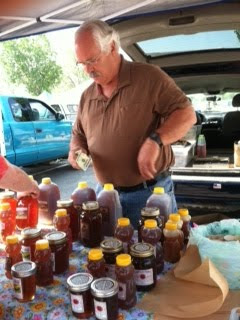Once, while living in San Francisco, I was described by a co-worker as a pioneer woman. I might have slipped into our conversation how last Christmas I made friends and family homemade apple butter. But just because a girl cannot bear to throw away the fruits of an apple tree in her front yard and subsequently teaches herself to jar the apple butter she makes from the fruits so as not to waste them, does not really make her a pioneer woman. Maybe I was trying to avoid a) the idea of Christmas altogether and b) the capitalist/corporate/economic system citizens happily pour their money into during this time of year.
Despite all that, I stood there listening to my co-worker poke fun at me, daydreaming about life on the prairie—the tall grasses covered with frost, snow softly falling onto the roof of my shack, shelves lined with jars of preserved food, cut logs on the side of the house for burning, cast-iron pans atop my wood burning stove, my hunting dog asleep in front of the fire, roasting pheasant I had hunted that morning with potatoes I had preserved in my root cellar—a romantic survival involving suffering, strength and trepidation. These were the days where survival was a measure of how self-sufficient you were. Survival in San Francisco was something else completely—you put on your fashionable clothes and mean mug, carry your bike down 3 flights of stairs and head out the door and into the grind. But what does all that mean? To me I felt disconnected from land, open wild air, growth, self-sufficiency. I flipped through the slides in my memory and fixated on my earliest recollection of an attempt at sustainability.
Since I was in elementary school I have been concerned with the state of the world. Admittedly, and I will blame this on being mostly an only child (mostly, because when I was 15 my mother finally had another) I have always been something of a General. Okay, maybe General Stephanie is too harsh but some might describe me as bossy. Whether my fellow YMCA after-school program attendees were really into or not, I started a recycling club. I spent time at home making reduce, reuse and recycle signs—the 3 R’s. The next day I would gather my recycling club members, shove a 3 R’s sign in their hands and tell them our mission for the day: Dig through the garbage, pick out recyclable paper and put it in the recycle bins. I cannot recall that club lasting a very long time but the concern never left my mind. I remember my mother listening incessantly to my begging for her to get recycle bins despite the fact that curbside pick-up had not yet started in our town.
20 years later this begging left me with buckets full of apples and an inability to toss them into the compost or worse yet, the garbage can! I could not have known at the time that jarring food would be the beginning of my passion for food. And now my friends, I want to share my passion for food with you.























